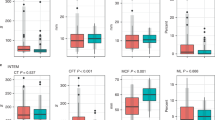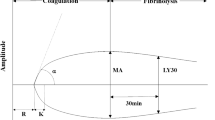Background
This study aimed to explore the hemostatic profile of neonates with necrotizing enterocolitis (NEC) using Rotational Thromboelastometry (ROTEM) and to investigate if ROTEM parameters have the capacity to play a role in the differentiation of NEC from sepsis at the disease onset.
Methods
This observational study included 62 neonates (mean gestational age 31.6 weeks and mean birth weight 1620g) hospitalized in a neonatal intensive care unit. The neonates were categorized in three groups: neonates with NEC (Bell stage II and above), neonates with sepsis and healthy neonates and they were matched 1:1:1 with regards to gestational age, delivery mode, and sex. Clinical, laboratory data as well as measurements of ROTEM parameters at disease onset were recorded.
Results
ROTEM parameters differed between neonates with NEC and neonates with sepsis, indicating that NEC results in accelerated clot formation and higher clot strength compared to sepsis. The EXTEM CFT and A10 parameters demonstrated the highest diagnostic performance for NEC in terms of discrimination between NEC and sepsis (AUC, 0.997; 95% CI: 0.991–1.000 and 0.973; 95% CI: 0.932–1.000, respectively).
Conclusions
Neonates with NEC manifested accelerated clot formation and higher clot strength compared to septic and healthy neonates, as these were expressed by ROTEM parameters.
Impact
-
This work reports data on the hemostatic profile of neonates with necrotizing enterocolitis (NEC) using Rotational Thromboelastometry (ROTEM) and the capacity of ROTEM parameters in differentiating of NEC from sepsis at the disease onset.
-
Neonates with NEC present acceleration of coagulation and exhibit a hypercoagulable profile, as this is expressed by ROTEM parameters, in comparison to septic and healthy neonates.
-
ROTEM parameters demonstrated a good diagnostic capacity in differentiating NEC from sepsis at the disease onset.
This is a preview of subscription content, access via your institution
Access options
Subscribe to this journal
Receive 14 print issues and online access
$259.00 per year
only $18.50 per issue
Buy this article
- Purchase on Springer Link
- Instant access to full article PDF
Prices may be subject to local taxes which are calculated during checkout

Similar content being viewed by others
Data availability
The datasets generated during and/or analysed during the current study are available from the corresponding author (R.S.) on reasonable request.
References
Niemarkt, H. J. et al. Necrotizing enterocolitis, gut microbiota, and brain development: role of the brain-gut axis. Neonatology 115, 423–431 (2019).
Yee, W. H. et al. Incidence and timing of presentation of necrotizing enterocolitis in preterm infants. Pediatrics 129, e298–e304 (2012).
Knell, J., Han, S. M., Jaksic, T. & Modi, B. P. Current status of necrotizing enterocolitis. Curr. Probl. Surg. 56, 11–38 (2019).
Neu, J. & Walker, W. A. Necrotizing enterocolitis. N. Engl. J. Med. 364, 255–264 (2011).
Neu, J. Necrotizing enterocolitis: the future. Neonatology 117, 240–244 (2020).
Duncan, C. F., Youngstein, T., Kirrane, M. D. & Lonsdale D. O. Diagnostic challenges in sepsis. Curr. Infect. Dis. Rep. 23, 12 (2021).
D’Angelo, G. et al. Current status of laboratory and imaging diagnosis of neonatal necrotizing enterocolitis. Ital. J. Pediatr. 44, 84 (2018).
Walsh, T. S. et al. Prevalence, management, and outcomes of critically ill patients with prothrombin time prolongation in United Kingdom intensive care units. Crit. Care Med. 38, 1939–1946 (2010).
Zeerleder, S., Hack, C. E. & Wuillemin, W. A. Disseminated intravascular coagulation in sepsis. Chest 128, 2864–2875 (2005).
Feng, W. et al. Application of coagulation parameters at the time of necrotizing enterocolitis diagnosis in surgical intervention and prognosis. BMC Pediatr. 22, 259 (2022).
Tao, G. Z. et al. Impaired activity of blood coagulant factor XIII in patients with necrotizing enterocolitis. Sci. Rep. 5, 13119 (2015).
Giuliani, S. et al. Coagulation gene expression profiling in infants with necrotizing enterocolitis. J. Pediatr. Gastroenterol. Nutr. 63, e169–e175 (2016).
Lampridou, M. et al. ROTEM diagnostic capacity for measuring fibrinolysis in neonatal sepsis. Thromb. Res. 192, 103–108 (2020).
Sokou, R. et al. Development and validation of a sepsis diagnostic scoring model for neonates with suspected sepsis. Front. Pediatr. 10, 1004727 (2022).
Eliwan, H. et al. Protein C pathway in paediatric and neonatal sepsis. Front. Pediatr. 9 (2022).
Del Vecchio, A., Stronati, M., Franco, C. & Christensen, R. D. Bi-directional activation of inflammation and coagulation in septic neonates. Early Hum. Dev. 90, S22–S25 (2014).
Sokou, R. et al. Reference ranges of thromboelastometry in healthy full-term and pre-term neonates. Clin. Chem. Lab. Med. 55, 1592–1597 (2017).
McGovern, M. et al. Challenges in developing a consensus definition of neonatal sepsis. Pediatr. Res. 88, 14–26 (2020).
Gephart, S. M. et al. Changing the paradigm of defining, detecting, and diagnosing NEC: perspectives on Bell’s stages and biomarkers for NEC. Semin. Pediatr. Surg. 27, 3–10 (2018).
Gordon, P. V., Swanson, J. R., MacQueen, B. C. & Christensen, R. D. A critical question for NEC researchers: can we create a consensus definition of NEC that facilitates research progress? Semin. Perinatol. 41, 7–14 (2017).
Patel, R. M. et al. Defining necrotizing enterocolitis: current difficulties and future opportunities. Pediatr. Res. 88, 10–15 (2020).
Walsh, M. C. & Kliegman, R. M. Necrotizing enterocolitis: treatment based on staging criteria. Pediatr. Clin. North Am. 33, 179–201 (1986).
Richardson, D. K., Corcoran, J. D., Escobar, G. J. & Lee, S. K. SNAP-II and SNAPPE-II: simplified newborn illness severity and mortality risk scores. J. Pediatr. 138, 92–100 (2001).
Fleiss, N. et al. Evaluation of the neonatal sequential organ failure assessment and mortality risk in preterm infants with late-onset infection. JAMA Netw. Open 4, e2036518 (2021).
Cetinkaya, M., Köksal, N. & Özkan, H. A new scoring system for evaluation of multiple organ dysfunction syndrome in premature infants. Am. Assoc. Crit. Care Nurses 21, 328–337 (2012).
Töllner, U. Early diagnosis of septicemia in the newborn. Clinical studies and sepsis score. Eur. J. Pediatr. 138, 331–337 (1982).
Bizzarro, M. J., Ehrenkranz, R. A. & Gallagher, P. G. Concurrent bloodstream infections in infants with necrotizing enterocolitis. J. Pediatr. 164, 61–66 (2014).
Garg, P. M. et al. Clinical impact of NEC-associated sepsis on outcomes in preterm infants. Pediatr. Res. 92, 1705–1715 (2022).
Song, R., Subbarao, G. C. & Maheshwari, A. Haematological abnormalities in neonatal necrotizing enterocolitis. J. Matern. Fetal Neonatal Med. 25, 22–25 (2012).
Tsantes, A. G. et al. Sepsis-induced coagulopathy: an update on pathophysiology, biomarkers, and current guidelines. Life 13, 350 (2023).
Gong, F. C. et al. Identification of potential biomarkers and immune features of sepsis using bioinformatics analysis. Mediators Inflamm. 2020, 3432587 (2020).
van der Poll, T. & Herwald, H. The coagulation system and its function in early immune defense. Thromb. Haemost. 112, 640–648 (2014).
Engelmann, B. & Massberg, S. Thrombosis as an intravascular effector of innate immunity. Nat. Rev. Immunol. 13, 34–45 (2013).
Sokou, R. et al. Thromboelastometry for diagnosis of neonatal sepsis-associated coagulopathy: an observational study. Eur. J. Pediatr. 177, 355–362 (2018).
Namachivayam, K., MohanKumar, K. & Shores, D. R. Targeted inhibition of thrombin attenuates murine neonatal necrotizing enterocolitis. Proc. Natl. Acad. Sci. USA 117, 10958–10969 (2020).
Maheshwari, A. Role of platelets in neonatal necrotizing enterocolitis. Pediatr. Res. 89, 1087–1093 (2021).
Fernandes, C. J. & O’Donovan, D. J. Platelet transfusions in infants with necrotizing enterocolitis. Curr. Hematol. Rep. 5, 76–81 (2006).
Curley, A. et al. Randomized trial of platelet-transfusion thresholds in neonates. N. Engl. J. Med. 380, 242–251 (2019).
Baer, V. L. et al. Do platelet transfusions in the NICU adversely affect survival? Analysis of 1600 thrombocytopenic neonates in a multihospital healthcare system. J. Perinatol. 27, 790–796 (2007).
Parastatidou, S. et al. The role of ROTEM variables based on clot elasticity and platelet component in predicting bleeding risk in thrombocytopenic critically ill neonates. Eur. J. Haematol. 106, 175–183 (2021).
Autmizguine, J. et al. Anaerobic antimicrobial therapy after necrotizing enterocolitis in VLBW infants. Pediatrics 135, e117–e125 (2015).
Hackam, D. J., Sodhi, C. P. & Good, M. New insights into necrotizing enterocolitis: from laboratory observation to personalized prevention and treatment. J. Pediatr. Surg. 54, 398–404 (2019).
Author information
Authors and Affiliations
Contributions
R.S., A.E.T., and P.M. conceptualized the project. R.S., P.M., A.E.T., and A.G.T. designed the methodology. R.S., A.K., G.I., A.G.T., S.P., M.L., D.H., N.I., P.M., A.V., and S.K. were involved in data collection. AG.T, D.P., S.B., P.M., A.E.T., R.S., and A.K. were involved in analysis and data interpretation. A.E.T., R.S., A.GT., A.K., and P.M. wrote the manuscript. All the co-authors critically revised and finally approved the manuscript. All authors agree to be held accountable for all aspects of the work in ensuring that questions related to the accuracy or integrity of any part of the work are appropriately investigated and resolved. All authors have read and agreed to the published version of the manuscript.
Corresponding author
Ethics declarations
Competing interests
The authors declare no competing interests.
Informed consent
Written informed consent has been obtained by parents or guardians of enrolled neonates.
Additional information
Publisher’s note Springer Nature remains neutral with regard to jurisdictional claims in published maps and institutional affiliations.
Rights and permissions
Springer Nature or its licensor (e.g. a society or other partner) holds exclusive rights to this article under a publishing agreement with the author(s) or other rightsholder(s); author self-archiving of the accepted manuscript version of this article is solely governed by the terms of such publishing agreement and applicable law.
About this article
Cite this article
Sokou, R., Mantzios, P., Tsantes, A.G. et al. Assessment of hemostatic profile in neonates with necrotizing enterocolitis using Rotational Thromboelastometry (ROTEM). Pediatr Res (2023). https://doi.org/10.1038/s41390-023-02958-8
Received:
Revised:
Accepted:
Published:
DOI: https://doi.org/10.1038/s41390-023-02958-8
This article is cited by
-
Do hematological biomarkers predict surgical necrotizing enterocolitis?
Pediatric Research (2024)



